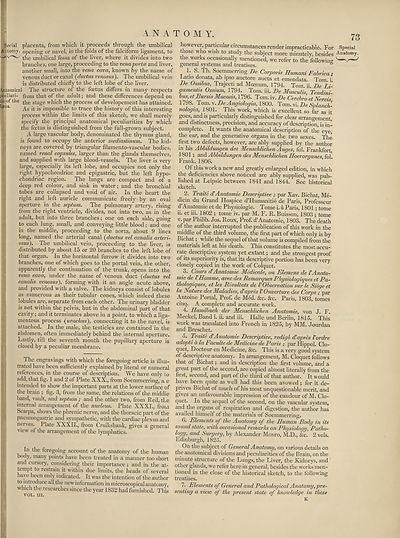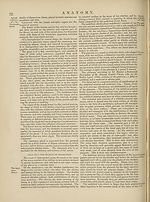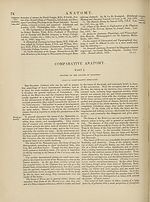Encyclopaedia Britannica > Volume 3, Anatomy-Astronomy
(81) Page 73
Download files
Complete book:
Individual page:
Thumbnail gallery: Grid view | List view

ANATOMY.
Jecial placenta, from which it proceeds through the umbilical
tomy. opening or navel, in the folds of the falciform ligament, to
the umbilical fossa of the liver, where it divides into two
branches, one large, proceeding to the venaportce and liver,
another small, into the vena cava, known by the name of
venous duct or canal {ductus venosus). The umbilical vein
is distributed chiefly to the left lobe of the liver,
comical The structure of the foetus differs in many respects
liari- fr0ni that of the adult; and these differences depend on
°f the t]ie gtage which the process of developement has attained.
9' As it is impossible to trace the history of this interesting
process within the limits of this sketch, we shall merely
specify the principal anatomical peculiarities by which
the foetus is distinguished from the full-grown subject.
A large vascular body, denominated the thymus gland,
is found to occupy the anterior mediastinum. The kid¬
neys are covered by triangular filamento-vascular bodies,
named renal capsules, larger than the glands themselves,
and supplied with large blood-vessels. The liver is very
large, especially its left lobe, and occupies not only the
right hypochondriac and epigastric, but the left hypo¬
chondriac region. The lungs are compact and of a
deep red colour, and sink in water; and the bronchial
tubes are collapsed and void of air. In the heart the
right and left auricle communicate freely by an oval
aperture in the septum. The pulmonary*^ artery, rising
from the right ventricle, divides, not into two, as in the
adult, but into three branches; one on each side, going
to each lung, small, and conveying little blood; and one
in the middle, proceeding to the aorta, about 9 lines
long, named the arterial canal {ductus vel canalis arteri¬
osus). The umbilical vein, proceeding to the liver, is
distributed by about 15 or 20 branches to the left lobe of
that organ. In the horizontal furrow it divides into two
branches, one of which goes to the portal vein, the other,
apparently the continuation of the trunk, opens into the
vena cava, under the name of venous duct {ductus vel
canalis venosus), forming with it an angle acute above,
and provided with a valve. The kidneys consist of lobules
as numerous as their tubular cones, which indeed these
lobules are, separate from each other. The urinary bladder
is not within the pelvis, but in the abdominal part of that
cavity; and it terminates above in a point, to which a liga¬
mentous process {urachus), connecting it to the navel, is
attached. In the male, the testicles are contained in the
abdomen, often immediately behind the internal aperture.
Lastly, till the seventh month the pupillary aperture is
closed by a peculiar membrane.
The engravings with which the foregoing article is illus¬
trated have been sufficiently explained by literal or numeral
references, in the course of description. We have only to
add, that fig. 1 and 2 of Plate XXX., from Soemmerring, a, e
intended to show the important parts at the lower surface of
the brain ; fig. 3, from the same, the relations of the middie
band, vault, and septum; and the other two, from Reil, the
internal arrangement of the nucleus. Plate XXXI., from
Scarpa, shows the phrenic nerve, and the thoracic part of the
pneumogastric and sympathetic, with the cardiac plexus and
nerves. 1 late XXXII., from Cruikshank, gives a general
view of the arrangement of the lymphatics. "
In the foregoing account of the anatomy of the human
body, many points have been treated in a manner too short
and cursory, considering their importance ; and in the at¬
tempt to restrain it within due limits, the heads of several
uiye been only indicated. It was the intention of the author
to introduce all the new information in microscopical anatomy,
which the researches since the year 1832 had furnished. This
VOL. III.
73
lowever, particular circumstances render impracticable. For Special
those who wish to study the subject more minutely, besides Anatomy,
the works occasionally mentioned, we refer to the following1
general systems and treatises. °
1. S. Th. Soemmerring De Corporis Humani Fabrica ;
Latio donata, ab ipso auctore aucta et emendata. Tom i
De Ossibus, Trajecti ad Moenum, 1794. Tom ii De Li-
gamentis Ossium, 1794. Tom. iii. De Musculis, Tendini-
bus, et Bursts Mucosis, 1796. Tom. iv. De Cerebro et Nereis
1798. Tom. v. De Angiologia, 1800. Tom. vi. De Splanch-
nologia, 1801. This work, which is excellent so far as it
goes, and is particularly distinguished for clear arrangement,
and distinctness, precision, and accuracy of description, is in¬
complete. It wants the anatomical description of the eye,
the ear, and the generative organs in the two sexes. The
first two defects, however, are ably supplied by the author
in his Abbildungen des Menschlichen Auges, fol. Frankfort
1801; and Abbildungen des Menschlichen Hoerorqanes. fob
Frank. 1806.
Of this work a new and greatly enlarged edition, in which
the deficiencies above noticed are ably supplied, was pub¬
lished at Leipsic between 1841 and 1844. See historical
sketch.
2. Traite AAnatomie Descriptive ; par Xav. Bichat, Me¬
dian du Grand Hospice d’Humanitie de Paris, Professeur
d’Anatomie et de Physiologie. Tome i. a Paris, 1801; tome
ii. et iii. 1802 ; tome iv. par M. F. R. Buisson, 1803 ; tome
v. par Philib. Jos. Roux, Prof. d’Anatomie, 1803. The death
of the author interrupted the publication of this work in the
middle of the third volume, the first part of which only is by
Bichat; while the sequel of that volume is compiled from the
materials left at his death. This constitutes the most accu¬
rate descriptive system yet extant; and the strongest proof
of its superiority is, that its descriptive portion has been very
closely copied in the work of Colquet.
3. Cours dAnatomie Medicale, ou Siemens de VAnato¬
mie de VHomme, avec des Remarques Physiologiques et Pa-
thologtques, et les Resultats de V Observation sur le Siege et
la Nature des Maladies, dapres VOuverture des Corps ; par
Antoine Portal, Prof, de Med. &c. &c. Paris, 1803, tomes
cinq. A complete and accurate work.
4. Handbuch der Menschlichen Anatomie, von J. F.
Meckel, Band i. ii. and iii. Halle und Berlin, 1815. This
work was translated into French in 1825, by MM. Jourdan
and Breschet.
5. Traite d!Anatomie Descriptive, redige d’apres Vordre
adopte d la Faculte de Medicine de Paris ; par Hippol. Clo¬
quet, Docteur en Medicine, &c. This is a very good system
of descriptive anatomy. In arrangement, M. Cloquet follows
that of Bichat; and in description the first volume, and a
great part of the second, are copied almost literally from the
first, second, and part of the third of that author. It would
have been quite as well had this been avowed; for it de¬
prives Bichat of much of his most unquestionable merit, and
gives an unfavourable impression of the candour of M. Clo¬
quet. In the sequel of the second, on the vascular system,
and the organs of. respiration and digestion, the author has
availed himself of the materials of Soemmerring.
6. Elements of the Anatomy of the Human Body in its
sound state, ivith occasional remarks on Physiology, Patho-
logy, and Surgery, by Alexander Monro, M.D., &c. 2 vols.
Edinburgh, 1825.
On the subject of General Anatomy, on various details on
the anatomical divisions and peculiarities of the Brain, on the
minute structure of the Lungs, the Liver, the Kidneys, and
other glands, we refer here in general, besides the works men¬
tioned in the close of the historical sketch, to the following
treatises.
7. Elements of General and Pathological Anatomy, pre¬
senting a view of the present state of knowledge in these
Jecial placenta, from which it proceeds through the umbilical
tomy. opening or navel, in the folds of the falciform ligament, to
the umbilical fossa of the liver, where it divides into two
branches, one large, proceeding to the venaportce and liver,
another small, into the vena cava, known by the name of
venous duct or canal {ductus venosus). The umbilical vein
is distributed chiefly to the left lobe of the liver,
comical The structure of the foetus differs in many respects
liari- fr0ni that of the adult; and these differences depend on
°f the t]ie gtage which the process of developement has attained.
9' As it is impossible to trace the history of this interesting
process within the limits of this sketch, we shall merely
specify the principal anatomical peculiarities by which
the foetus is distinguished from the full-grown subject.
A large vascular body, denominated the thymus gland,
is found to occupy the anterior mediastinum. The kid¬
neys are covered by triangular filamento-vascular bodies,
named renal capsules, larger than the glands themselves,
and supplied with large blood-vessels. The liver is very
large, especially its left lobe, and occupies not only the
right hypochondriac and epigastric, but the left hypo¬
chondriac region. The lungs are compact and of a
deep red colour, and sink in water; and the bronchial
tubes are collapsed and void of air. In the heart the
right and left auricle communicate freely by an oval
aperture in the septum. The pulmonary*^ artery, rising
from the right ventricle, divides, not into two, as in the
adult, but into three branches; one on each side, going
to each lung, small, and conveying little blood; and one
in the middle, proceeding to the aorta, about 9 lines
long, named the arterial canal {ductus vel canalis arteri¬
osus). The umbilical vein, proceeding to the liver, is
distributed by about 15 or 20 branches to the left lobe of
that organ. In the horizontal furrow it divides into two
branches, one of which goes to the portal vein, the other,
apparently the continuation of the trunk, opens into the
vena cava, under the name of venous duct {ductus vel
canalis venosus), forming with it an angle acute above,
and provided with a valve. The kidneys consist of lobules
as numerous as their tubular cones, which indeed these
lobules are, separate from each other. The urinary bladder
is not within the pelvis, but in the abdominal part of that
cavity; and it terminates above in a point, to which a liga¬
mentous process {urachus), connecting it to the navel, is
attached. In the male, the testicles are contained in the
abdomen, often immediately behind the internal aperture.
Lastly, till the seventh month the pupillary aperture is
closed by a peculiar membrane.
The engravings with which the foregoing article is illus¬
trated have been sufficiently explained by literal or numeral
references, in the course of description. We have only to
add, that fig. 1 and 2 of Plate XXX., from Soemmerring, a, e
intended to show the important parts at the lower surface of
the brain ; fig. 3, from the same, the relations of the middie
band, vault, and septum; and the other two, from Reil, the
internal arrangement of the nucleus. Plate XXXI., from
Scarpa, shows the phrenic nerve, and the thoracic part of the
pneumogastric and sympathetic, with the cardiac plexus and
nerves. 1 late XXXII., from Cruikshank, gives a general
view of the arrangement of the lymphatics. "
In the foregoing account of the anatomy of the human
body, many points have been treated in a manner too short
and cursory, considering their importance ; and in the at¬
tempt to restrain it within due limits, the heads of several
uiye been only indicated. It was the intention of the author
to introduce all the new information in microscopical anatomy,
which the researches since the year 1832 had furnished. This
VOL. III.
73
lowever, particular circumstances render impracticable. For Special
those who wish to study the subject more minutely, besides Anatomy,
the works occasionally mentioned, we refer to the following1
general systems and treatises. °
1. S. Th. Soemmerring De Corporis Humani Fabrica ;
Latio donata, ab ipso auctore aucta et emendata. Tom i
De Ossibus, Trajecti ad Moenum, 1794. Tom ii De Li-
gamentis Ossium, 1794. Tom. iii. De Musculis, Tendini-
bus, et Bursts Mucosis, 1796. Tom. iv. De Cerebro et Nereis
1798. Tom. v. De Angiologia, 1800. Tom. vi. De Splanch-
nologia, 1801. This work, which is excellent so far as it
goes, and is particularly distinguished for clear arrangement,
and distinctness, precision, and accuracy of description, is in¬
complete. It wants the anatomical description of the eye,
the ear, and the generative organs in the two sexes. The
first two defects, however, are ably supplied by the author
in his Abbildungen des Menschlichen Auges, fol. Frankfort
1801; and Abbildungen des Menschlichen Hoerorqanes. fob
Frank. 1806.
Of this work a new and greatly enlarged edition, in which
the deficiencies above noticed are ably supplied, was pub¬
lished at Leipsic between 1841 and 1844. See historical
sketch.
2. Traite AAnatomie Descriptive ; par Xav. Bichat, Me¬
dian du Grand Hospice d’Humanitie de Paris, Professeur
d’Anatomie et de Physiologie. Tome i. a Paris, 1801; tome
ii. et iii. 1802 ; tome iv. par M. F. R. Buisson, 1803 ; tome
v. par Philib. Jos. Roux, Prof. d’Anatomie, 1803. The death
of the author interrupted the publication of this work in the
middle of the third volume, the first part of which only is by
Bichat; while the sequel of that volume is compiled from the
materials left at his death. This constitutes the most accu¬
rate descriptive system yet extant; and the strongest proof
of its superiority is, that its descriptive portion has been very
closely copied in the work of Colquet.
3. Cours dAnatomie Medicale, ou Siemens de VAnato¬
mie de VHomme, avec des Remarques Physiologiques et Pa-
thologtques, et les Resultats de V Observation sur le Siege et
la Nature des Maladies, dapres VOuverture des Corps ; par
Antoine Portal, Prof, de Med. &c. &c. Paris, 1803, tomes
cinq. A complete and accurate work.
4. Handbuch der Menschlichen Anatomie, von J. F.
Meckel, Band i. ii. and iii. Halle und Berlin, 1815. This
work was translated into French in 1825, by MM. Jourdan
and Breschet.
5. Traite d!Anatomie Descriptive, redige d’apres Vordre
adopte d la Faculte de Medicine de Paris ; par Hippol. Clo¬
quet, Docteur en Medicine, &c. This is a very good system
of descriptive anatomy. In arrangement, M. Cloquet follows
that of Bichat; and in description the first volume, and a
great part of the second, are copied almost literally from the
first, second, and part of the third of that author. It would
have been quite as well had this been avowed; for it de¬
prives Bichat of much of his most unquestionable merit, and
gives an unfavourable impression of the candour of M. Clo¬
quet. In the sequel of the second, on the vascular system,
and the organs of. respiration and digestion, the author has
availed himself of the materials of Soemmerring.
6. Elements of the Anatomy of the Human Body in its
sound state, ivith occasional remarks on Physiology, Patho-
logy, and Surgery, by Alexander Monro, M.D., &c. 2 vols.
Edinburgh, 1825.
On the subject of General Anatomy, on various details on
the anatomical divisions and peculiarities of the Brain, on the
minute structure of the Lungs, the Liver, the Kidneys, and
other glands, we refer here in general, besides the works men¬
tioned in the close of the historical sketch, to the following
treatises.
7. Elements of General and Pathological Anatomy, pre¬
senting a view of the present state of knowledge in these
Set display mode to:
![]() Universal Viewer |
Universal Viewer | ![]() Mirador |
Large image | Transcription
Mirador |
Large image | Transcription
Images and transcriptions on this page, including medium image downloads, may be used under the Creative Commons Attribution 4.0 International Licence unless otherwise stated. ![]()
| Encyclopaedia Britannica > Encyclopaedia Britannica > Volume 3, Anatomy-Astronomy > (81) Page 73 |
|---|
| Permanent URL | https://digital.nls.uk/193758401 |
|---|
| Attribution and copyright: |
|
|---|---|
| Shelfmark | EB.16 |
|---|---|
| Description | Ten editions of 'Encyclopaedia Britannica', issued from 1768-1903, in 231 volumes. Originally issued in 100 weekly parts (3 volumes) between 1768 and 1771 by publishers: Colin Macfarquhar and Andrew Bell (Edinburgh); editor: William Smellie: engraver: Andrew Bell. Expanded editions in the 19th century featured more volumes and contributions from leading experts in their fields. Managed and published in Edinburgh up to the 9th edition (25 volumes, from 1875-1889); the 10th edition (1902-1903) re-issued the 9th edition, with 11 supplementary volumes. |
|---|---|
| Additional NLS resources: |
|

